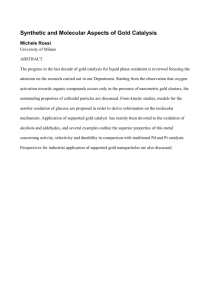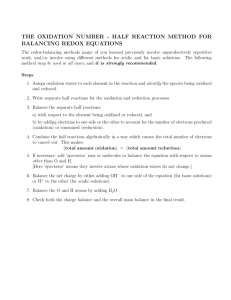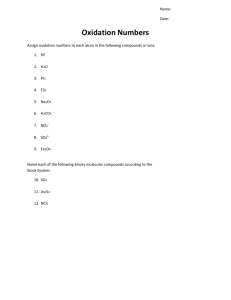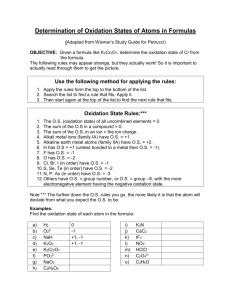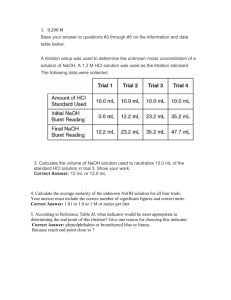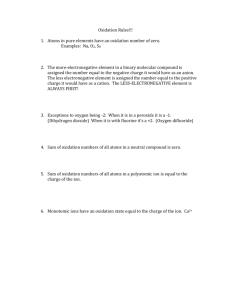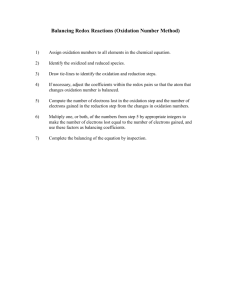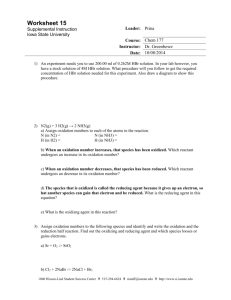Oregon State University, Summer 2009 Chemistry 121 Final Exam
advertisement
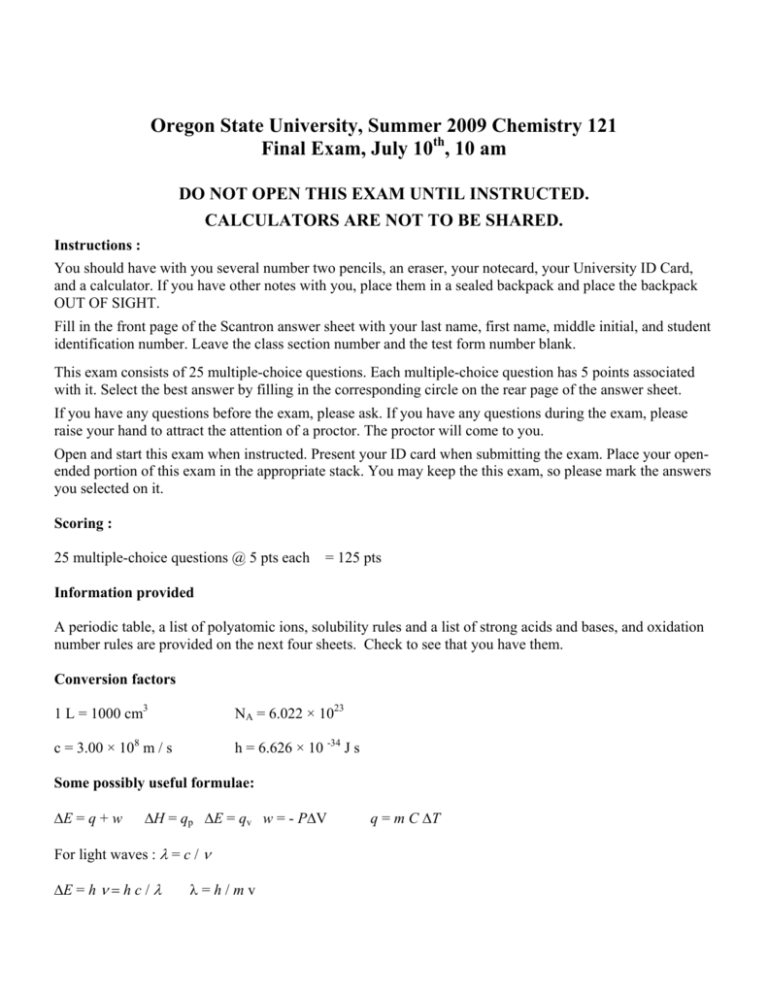
Oregon State University, Summer 2009 Chemistry 121 Final Exam, July 10th, 10 am DO NOT OPEN THIS EXAM UNTIL INSTRUCTED. CALCULATORS ARE NOT TO BE SHARED. Instructions : You should have with you several number two pencils, an eraser, your notecard, your University ID Card, and a calculator. If you have other notes with you, place them in a sealed backpack and place the backpack OUT OF SIGHT. Fill in the front page of the Scantron answer sheet with your last name, first name, middle initial, and student identification number. Leave the class section number and the test form number blank. This exam consists of 25 multiple-choice questions. Each multiple-choice question has 5 points associated with it. Select the best answer by filling in the corresponding circle on the rear page of the answer sheet. If you have any questions before the exam, please ask. If you have any questions during the exam, please raise your hand to attract the attention of a proctor. The proctor will come to you. Open and start this exam when instructed. Present your ID card when submitting the exam. Place your openended portion of this exam in the appropriate stack. You may keep the this exam, so please mark the answers you selected on it. Scoring : 25 multiple-choice questions @ 5 pts each = 125 pts Information provided A periodic table, a list of polyatomic ions, solubility rules and a list of strong acids and bases, and oxidation number rules are provided on the next four sheets. Check to see that you have them. Conversion factors 1 L = 1000 cm3 NA = 6.022 × 1023 c = 3.00 × 108 m / s h = 6.626 × 10 -34 J s Some possibly useful formulae: ∆E = q + w ∆H = qp ∆E = qv w = - P∆V For light waves : λ = c / ν ∆E = h ν = h c / λ λ=h/mv q = m C ∆T Group 1 2 3 4 5 6 7 1A 2A 3B 4B 5B 6B 7B KEY Atomic number ! Symbol ! Atomic mass ! 1 1 H 1.00794 2 3 4 5 6 7 3 4 Li Be 6.941 9.01218 8 9 10 8B 11 12 13 14 15 16 17 18 1B 2B 3A 4A 5A 6A 7A 8A 2 1 He H 4.00260 1.0079 5 6 7 8 9 10 B C N O F Ne 10.811 12.011 14.0067 15.9994 18.9984 20.1797 11 12 13 14 15 16 17 18 Na Mg Al Si P S Cl Ar 22.9898 24.3050 26.9815 28.0855 30.9738 32.066 35.4527 39.948 19 20 21 22 23 24 25 26 27 28 29 30 31 32 33 34 35 36 K Ca Sc Ti V Cr Mn Fe Co Ni Cu Zn Ga Ge As Se Br Kr 39.0983 40.078 44.9559 47.88 50.9415 51.9961 54.9381 55.847 58.9332 58.69 63.546 65.39 69.723 72.59 74.9216 78.96 79.904 83.80 37 38 39 40 41 42 43 44 45 46 47 48 49 50 51 52 53 54 Rb Sr Y Zr Nb Mo Tc Ru Rh Pd Ag Cd In Sn Sb Te I Xe 85.4678 87.62 88.9059 91.224 92.9064 95.94 (98) 101.07 102.906 106.42 107.868 112.411 114.818 118.710 121.75 127.60 126.9045 131.30 55 56 57-71 72 73 74 75 76 77 78 79 80 81 82 82 84 85 86 Cs Ba Hf Ta W Re Os Ir Pt Au Hg Tl Pb Bi Po At Rn 132.905 137.327 * Rare Earths 178.49 180.948 183.85 186.207 190.23 192.22 195.09 196.9665 200.59 204.37 207.2 208.9804 (209) (210) (222) 110 111 (269) (272) 87 88 89-103 104 105 106 107 108 109 Fr Ra ^ Rf Ha Sg Ns Hs Mt (223) 226.025 Actinides (261) (262) (263) (262) (265) (266) *Lanthanide Series 57 58 59 60 61 62 63 64 65 66 67 68 69 70 71 La Ce Pr Nd Pm Sm Eu Gd Tb Dy Ho Er Tm Yb Lu 138.906 140.12 140.9077 144.24 145 150.4 151.96 157.25 158.9254 162.50 164.9304 167.26 168.9342 173.04 174.967 ^Actinide 89 90 91 92 93 94 95 96 97 98 99 100 101 102 103 Series Ac Th Pa U Np Pu Am Cm Bk Cf Es Fm Md No Lr 227.028 232.0381 231.0359 238.029 237.0482 (244) (243) (247) (247) (251) (254) (257) (258) 259 262 Strong Acids HCl, HBr, HI HNO3 HClO4 H2SO4 Strong Bases LiOH, NaOH, KOH Ca(OH)2 (slightly soluble) Ba(OH)2 Sr(OH)2 CH121 Summer 2009 Final OXIDATION NUMBER RULES • The oxidation number of a free element is always 0. • The oxidation number of a monatomic ion equals the charge of the ion. • The oxidation number of fluorine in compounds is -1. • The oxidation number of hydrogen in compounds is +1. Exception: the oxidation number of hydrogen is -1 in metal hydrides, like CaH2. • The oxidation number of oxygen in compounds is -2. Exception: the oxidation number of oxygen is -1 in peroxides, like BaO2. • The oxidation number of Cl, Br, I in compounds is -1. Exception: when combined with O or F, the preceding rules apply. The oxidation numbers of all other elements in a compound adjust such that: • The sum of the oxidation numbers of all of the atoms in a neutral compound is 0. • The sum of the oxidation numbers in a polyatomic ion is equal to the charge of the ion. 3 CH121 Summer 2009 Final Midterms Material 1. What is the correct value for V to the correct number of significant figures? V = (4/3)πr3 a. b. c. d. e. 2. π = 3.1412 r = 2.000 cm 3 3 × 10 cm 3.3 × 101 cm3 33.50 cm3 33.51 cm3 33.506 cm3 I drop an iron nail weighing 25 g into a beaker of oil with a density of 0.80 g/mL. The volume of the oil increases by 3.2 mL. What is the density of iron? a. b. c. d. e. 3. 2 0.80 g/mL. 1.0 g/mL. 7.8 g/mL. 9.8 g/mL. 25 g/mL Which of the following statements is CORRECT? a. The 13C nucleus has 7 protons and 6 neutrons. b. The element with an isotope that has a mass number of 40 and equal numbers of protons and neutrons is Ca. c. A neutron has almost the same mass as a proton, but the opposite charge. d. An electron has the same charge as a proton. e. Hydrogen has only one isotope – 1H. 4. The charges on the monatomic ions of P, F, Rb and Al are: a. b. c. d. e. 5. -3, -1, +1, +3 +3, +1, -1, -3 -2, -1, +2, +3 -1, -2, +1, +2 -3, -2, +2, +3 What is the correct name of the compound, FeSO4? a. Iron (II) sulfite b. Iron sulfoxide c. Iron (III) sulfide d. Iron (III) sulfate e. Iron (II) sulfate 4 CH121 Summer 2009 Final 6. When the following equation is correctly balanced what is the ratio of moles of water produced to moles of oxygen (O2) that are consumed? __ C4H4(g) + __ O2(g) Æ __ CO2(g) + __ H2O(l) a. b. c. d e. 7. 4/5 4/1 2/4 3/5 2/5 How many grams of hydrogen are needed to reduce 10.0 g of tungsten oxide (WO3, 231.8 g/mol) to tungsten metal? WO3(s) + 3H2(g) Æ W(s) + 3H2O(l) a. b. c. d. e. 8. If I dissolve 24.2 g of Fe(NO3)3 (molar mass = 241.9 g/mol) in 500 mL of water, what is the concentration of nitrate ions in the resulting solution? a. b. c. d. e. 9. 0.261 g 0.0870 g 0.130 g 1.008 g 0.329 g 0.200 M 0.100 M 0.600 M 0.300 M 0.500 M Which of the following compounds will produce a precipitate when mixed with Ba(NO3)2(aq) solution? 1. NaOH(aq) 2. O2(g) 3. Pb(NO3)2(aq) a. b. c. d. e. 4. HCl(aq) 1 only 4 only 1 and 4 All of them None of them 5 CH121 Summer 2009 Final 10. Which of these statements is CORRECT? a. b. c. d. e. 11. Acids react with carbonates to make carbon dioxide. Oxidation is electron gain. A spectator ion is one that forms a precipitate. A base increases the concentration of protons in solution. Molarity is the number of moles of solute per liter of solvent. Which species are oxidized/reduced in the following reaction? Mg(s) + 2HCl(g) Æ MgCl2(aq) + H2(g) a. Mg and Cl in HCl are both reduced. b. Mg is oxidized and H in HCl is reduced. c. Cl in HCl is oxidized and H in HCl is reduced. d. H in HCl is oxidized and Mg is reduced. e. This is not a redox reaction. 12. Which of the following statements about a titration is INCORRECT? a. The equivalence point of an acid-base titration can be detected by the choice of the correct indicator. b. A volumetric flask contains an accurate volume of liquid. c. An acid-base titration can work if you add either base to acid, or acid to base. d. Titrations of the same volumes of 1 M HCl or 1 M H2SO4 will both require the same volume of 1 M NaOH for neutralization. e. Titrations can be used for redox reactions as well as acid-base reactions. 13. I perform the following acid/base neutralization titration. HCl(aq) + NaOH(aq) -------> NaCl(aq) + H2O(l) 25.0 mL of hydrochloric acid solution of unknown concentration required 50.0 mL of 1.00 M sodium hydroxide solution to be neutralized. What is the concentration of the acid? a. 0.50 M b. 1.00 M c. 2.00 M d. 2.50 M e. 5.00 M 6 CH121 Summer 2009 Final 14. Which of the following statements is CORRECT? a. Energy is the capacity of a body to keep a constant temperature. b. Kinetic energy refers to the energy possessed by virtue of the position of a body in the gravitational field of the Earth. c. Potential energy can never be converted into kinetic energy. d. Energy can be created or destroyed in chemical reactions. e. The kinetic energy of molecules of ice is less than that of molecules of room temperature water. 15. I heat a 55.9 g piece of Fe (specific heat = 0.449 J / g K) heated to 250 °C, then drop into a thermostatted water-bath maintained at 30 °C. What is the value of the heat q transferred from the Fe to the water when the Fe has come to the temperature of the bath? a. b. c. d. e. 16. If a gas expands during a constant pressure chemical process during which heat flows out of the system, which of the following is statements is CORRECT ? a. b. c. d. e. 17. +5.52 kJ -5.52 kJ – 98.8 J -6.27 kJ + 5.52 J q is positive and w is negative q is negative and w is positive q is positive and w is zero q is negative and w is negative q is zero and w is positive Which of the following statements is INCORRECT? a. The 1st Law of Thermodynamics is: ∆E = q + w. b. Enthalpy is the heat transfer at constant volume. c. When ∆H is negative, the process is exothermic. d. During a phase change the temperature does not change. e. If the heat of vaporization is x J/g, then the heat change when 1 g of the substance condenses from the gas to liquid is –x J/g. 7 CH121 Summer 2009 Final 18. Given the following reactions and enthalpy changes, )H = -393.5 kJ )H = -890.3 kJ )H = -285.8 kJ C(s) + O2(g) ÿ CO2 (g) CH4(g) + 2O2(g) ÿ CO2 (g) + 2H2O(l) H2(g) + ½ O2(g) ÿ H2O(l) use Hess’s Law calculate the enthalpy changes under standard conditions associated with the reaction C(s) + 2H2(g) ÿ CH4(g) a. b. c. d. e. )H = ? - 998 kJ + 74.8 kJ -74.8 kJ -211 kJ +211 kJ 19. Calculate the standard enthalpy of combustion of benzene (C6H6) give the following data. C6H6 (l) + 7.5O2 (g) Æ 6CO2 (g) + 3H2O (l) given the following enthalpies of formation : ∆Hof (kJ/mol) C6H6 (l) = +49.0 CO2 (g) = -393.5 H2O (l) = -285.8 (HINT : why is the value for O2(g) missing?) a. b. c. d. e. 20. -2696 kJ -3512 kJ -3267 kJ -3169 kJ -2897 kJ Arrange the following segments of the electromagnetic spectrum in order of increasing frequency. 1. AM radio 2. X-rays a. b. c. d. e. 3. Ultra-violet 4. Infra-red 1, 2, 3, 4 4, 3, 2, 1 1, 3, 4, 2 1, 4, 3, 2 3, 2, 1, 4 8 CH121 Summer 2009 Final 21. What is the energy contained in one photon from a UV laser that has a wavelength of 250 nm a. b. c. d. e. 22. 7.95 × 10 -28 J 6.63 × 10-34 J 7.95 ×10 -19 J 250 J 7.95 × 10 -19 kJ The diagram shows some transitions between energy levels in the H atom. Order the transitions by increasing wavelength. a. b. c. d. e. C, A, B B, C, A A, C, B C, B, A B, A, C n=4 n=3 A C n=2 B n=1 23. Which of the following represents an allowable set of quantum numbers? a. b. c. d. e. 24. n = 2, l = -2, ml = 2 n = 3, l = 3, ml = -3 n = 1, l = 0, ml = -1 n = 2, l = 1, ml = -1 n = 0, l = 0, ml = 0 The principal quantum number (n) and the magnetic quantum number (ml) determine respectively a. b. c. d. e. The size and orientation of an orbital. The orientation and shape of an orbital. The shape and size of an orbital. The size and shape of an orbital. The shape and orientation. 9 CH121 Summer 2009 Final 25. Select the correct list of orbital names for the following orbitals: a. b. c. d. e. s, dz2, py dxy, s, pz. py, s, dz2 py, s, dx2-y2 s, dxz, pz 10
